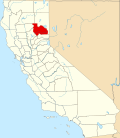History
Onion Valley was named for the wild onion plants native to the area. As a Gold Rush community, [2] population may have peaked at 1,500 in 1851 [3] with six hotels, a few stores and saloons, gambling parlor and a bowling alley. [4] Business started to decline at the end of 1851, and by 1853 only 120 settlers are noted. [5]
Organized ski club downhill speed races were held at Onion Valley starting in 1861, [6] with Sierra longboard skis referred to as "Norwegian snow-shoes". California Historical Landmarks No. 723 and 724 reference Onion Valley as a pioneer organized ski club in America. [7]
The 1880 population was listed as 23. A hotel [8] and the Eclipse mine was in the area. [9]
Photographs capture the decline of the area's human structures from 1905 [10] to 1953. [11]
This page is based on this
Wikipedia article Text is available under the
CC BY-SA 4.0 license; additional terms may apply.
Images, videos and audio are available under their respective licenses.



